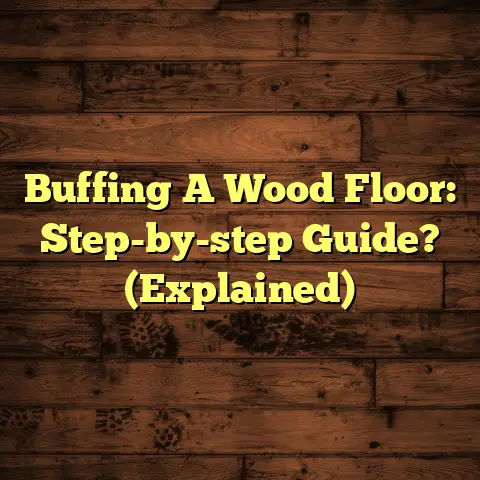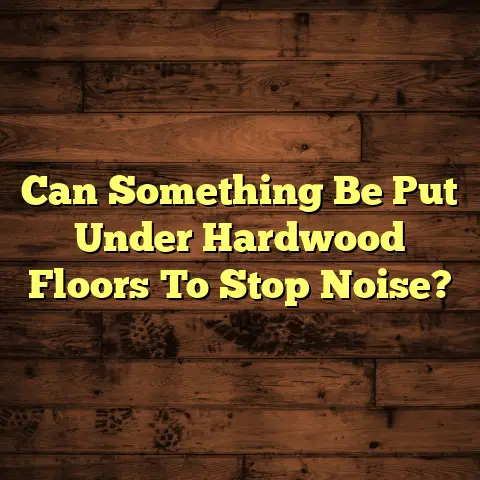Sticky Wood Floors? How to Clean (3 Steps to FIX!)
It’s like your floors are clinging to your shoes,
right?
It’s a frustrating problem, turning your home
from a sanctuary into a… well, a sticky trap!
I get it.
I’ve been there.
As a flooring contractor
for over 15 years, I’ve seen it all.
From toddlers
with rogue juice boxes to over-enthusiastic cleaning,
those sticky floors can be a real pain.
What causes this adhesive dilemma, you ask?
More importantly, how can you reclaim the pristine
condition of your beloved wood floors?
That’s what we’re diving into today.
We’re going to
uncover the common culprits behind sticky floors and
then walk through a straightforward, three-step
process to fix it.
Consider this your ultimate guide
to banishing stickiness and restoring the glory of
your hardwood.
Let’s get started!
Section 1: Understanding the Problem
Defining Sticky Wood Floors
So, what exactly are sticky wood floors?
It’s more than just a little grime.
It’s that distinct
feeling underfoot – a slight tackiness, a resistance
as you walk.
Think of it like this: imagine walking barefoot
on a freshly waxed car.
That’s the kind of sensation
we’re talking about.
Sometimes, it’s subtle; other
times, it’s so pronounced you can practically hear
your shoes peeling off the floor!
It’s important to distinguish sticky floors from
other wood floor problems.
Squeaky floors, for
example, are a noise issue, often caused by loose
subflooring or changes in humidity.
Creaky floors are similar.
Dull floors might lack shine but aren’t necessarily
sticky.
Sticky floors are about that tactile sensation
of something clinging to your feet.
Common Causes of Stickiness
Okay, let’s get down to the nitty-gritty.
What makes your wood floors sticky in the first place?
Here are some of the most common culprits I’ve encountered:
Residue from Cleaning Products: This is the big one.
Many cleaning products, especially those not specifically designed for hardwood, can leave behind a filmy residue.
This residue attracts dirt and grime, creating a sticky layer.I’ve seen clients use everything from dish soap to all-purpose cleaners on their hardwood, thinking they’re doing a good job.
Unfortunately, these products often contain ingredients that build up over time.Think about it: a detergent might clean initially, but it could leave behind polymers or waxes that attract dirt and grime.
These ingredients are great at cleaning other surfaces, but not so much on wood.
Specifically, avoid products containing:- Oils: These can leave a greasy residue.
- Waxes: While some wood floor cleaners contain wax, overuse or the wrong type can lead to build-up.
- Acrylic Polymers: These can create a sticky film.
- Ammonia: Harsh and can damage wood finishes.
Environmental Factors (Humidity & Temperature): Wood is a natural material, and it reacts to its environment.
High humidity can cause wood to expand and become sticky, especially if the finish is compromised.In regions with high humidity, like Florida or the Gulf Coast, this is a common problem.
The moisture in the air gets trapped in the finish, making it feel tacky.
Rapid temperature fluctuations can also cause issues.Accumulation of Dirt, Dust, and Debris: This one seems obvious, but it’s worth mentioning.
Over time, dirt, dust, and pet dander can accumulate on your floors, especially in high-traffic areas.
This layer of grime can contribute to the sticky feeling.Think about the entryway of your home.
All those shoes tracking in dirt and debris?
It adds up!
Regular sweeping and vacuuming are essential to prevent this.Wax Build-Up and Improper Refinishing: In the past, waxing wood floors was common.
However, applying too much wax or using the wrong type can lead to a thick, sticky build-up that’s difficult to remove.Also, if your floors were refinished improperly, the new finish might not have adhered correctly, leading to a sticky surface.
I’ve seen cases where homeowners tried to DIY refinishing and ended up with a gummy, uneven finish.
The Impact of Sticky Floors on Your Home
Sticky floors are more than just an annoyance; they can actually impact your home in several ways:
Aesthetic Appeal: Let’s face it, sticky floors look dirty, even if they’re not visibly soiled.
They can detract from the overall beauty of your home and make it feel less inviting.
A beautiful hardwood floor is a selling point, but a sticky one?
Not so much.Home Value: While it might seem minor, sticky floors can affect the perceived value of your home.
Potential buyers might see it as a sign of poor maintenance or a larger problem.
According to a 2023 survey by the National Association of Realtors, hardwood floors are still a desirable feature for homebuyers.Potential Health Implications (Mold & Mildew): In humid environments, sticky floors can create a breeding ground for mold and mildew.
The moisture trapped in the finish can encourage microbial growth, which can lead to health problems, especially for people with allergies or asthma.I’ve seen cases where homeowners didn’t realize they had a mold problem until they started experiencing allergy symptoms.
It’s not always visible, but that sticky surface can be a warning sign.
Personal Anecdotes or Case Studies
Let me share a couple of stories to illustrate this:
The Case of the Over-Enthusiastic Cleaner: I had a client, Sarah, who was meticulous about cleaning her floors.
She used a popular multi-surface cleaner, thinking it was safe for hardwood.
Over time, a thick, sticky residue built up.
She was frustrated because she was cleaning more often, but the floors just kept getting worse.
It took a specialized cleaning solution and a lot of elbow grease to remove the build-up and restore her floors.The Tale of the Humid Haven: Another client, John, lived in a coastal town with high humidity.
His floors were constantly sticky, even after cleaning.
We discovered that the humidity was seeping into the finish, causing the stickiness.
We recommended a dehumidifier and a specialized wood floor cleaner to combat the moisture.
These stories highlight the importance of understanding the
cause of your sticky floors before attempting to fix them.
It’s not always as simple as just mopping more often.
Section 2: Preparing to Clean
Okay, so you understand the problem.
Now, let’s get ready to
tackle those sticky floors!
Proper preparation is key to a
successful cleaning process.
Gathering Your Supplies
Before you start, gather everything you’ll need.
This will
save you time and prevent you from running around mid-cleaning.
Here’s a comprehensive list:
- Broom or Vacuum: For removing loose dirt and debris.
A vacuum with a soft brush attachment is ideal. - Microfiber Mop: Microfiber is gentle and effective at
picking up dirt and grime.
Avoid sponge mops, as they can push dirty water into the wood. - Two Buckets: One for clean water and one for rinsing
your mop.
This prevents you from spreading dirty water around your floors. - Cleaning Solution: More on this in a moment.
- Soft Cloths or Towels: For drying and buffing.
- Spray Bottle (Optional): For applying the cleaning solution.
- Fan (Optional): To help speed up the drying process.
Now, let’s talk about cleaning solutions. You have a few options:
Homemade Cleaner (Vinegar and Water): This is a classic and effective solution for removing residue.
Mix 1/2 cup of white vinegar with 1 gallon of warm water.
Vinegar is a natural degreaser and helps to dissolve build-up.- Pros: Inexpensive, readily available, natural.
- Cons: Can have a strong odor (which dissipates quickly), not suitable for all finishes.
Store-Bought Wood Floor Cleaner: Choose a cleaner specifically designed for hardwood floors.
Look for pH-neutral formulas that won’t damage the finish.
Brands like Bona and Method offer good options.- Pros: Convenient, often contains special ingredients to protect and enhance wood.
- Cons: Can be more expensive, some contain harsh chemicals.
DIY Baking Soda Paste: For stubborn stains and sticky spots, make a paste of baking soda and water.
Apply it to the affected area, let it sit for a few minutes, and then gently scrub.- Pros: Great for spot cleaning, gentle abrasive.
- Cons: Can be messy, needs to be rinsed thoroughly.
Isopropyl Alcohol (Spot Treatment): Isopropyl alcohol, also known as rubbing alcohol, can be effective for removing sticky residues like tape or glue.
Dilute the alcohol with water (1:1 ratio) and test it on an inconspicuous area first.
Apply the solution to a clean cloth and gently rub the sticky spot until it dissolves.
Wipe the area with a damp cloth to remove any remaining alcohol residue.- Pros: Excellent solvent for removing adhesives and other sticky substances.
- Cons: Can be harsh on some finishes, potentially causing discoloration or damage if not used carefully.
Note: Always test any cleaning solution on an inconspicuous area of your floor before applying it to the entire surface.
Safety Precautions
Safety first!
Cleaning products can contain chemicals that
can be harmful if not used properly.
Here are some safety
precautions to keep in mind:
- Wear Gloves: Protect your hands from harsh chemicals and prolonged exposure to water.
- Ensure Proper Ventilation: Open windows or turn on a fan to circulate air.
- Read Labels Carefully: Follow the manufacturer’s instructions for using cleaning products.
- Keep Out of Reach of Children and Pets: Store cleaning products in a safe place.
- Avoid Mixing Chemicals: Never mix different cleaning products, as this can create dangerous fumes.
- Test Cleaning Solutions: Before applying any cleaning solution to the entire floor, test it in an inconspicuous area to ensure it doesn’t damage the finish.
Assessing Your Wood Floor Type
Knowing your wood floor type is crucial.
Different types of
wood floors require different cleaning methods.
Here’s a
quick guide:
Finished vs.
Unfinished: Finished wood floors have a protective coating (such as polyurethane) that seals the wood and protects it from moisture.
Unfinished wood floors are more porous and require special care.- Finished: Can be cleaned with a damp mop and appropriate cleaning solution.
- Unfinished: Requires dry cleaning methods (sweeping or vacuuming) and specialized wood cleaners.
Solid vs.
Engineered: Solid hardwood floors are made of a single piece of wood, while engineered hardwood floors are made of multiple layers of wood bonded together.
Engineered floors are more resistant to moisture and temperature changes.- Solid: Can be sanded and refinished multiple times.
- Engineered: Can only be sanded and refinished a limited number of times (depending on the thickness of the top layer).
Type of Finish: Different finishes require different care.
Polyurethane finishes are durable and easy to clean, while wax finishes require regular waxing and buffing.
To determine your floor type, check your home’s documentation
or consult with a flooring professional.
If you’re unsure,
it’s always best to err on the side of caution and use a gentle
cleaning method.
Section 3: The Three-Step Cleaning Process
Alright, we’ve prepped and planned.
Now, it’s time for the
main event: cleaning those sticky floors!
Here’s my tried-and-true
three-step process:
Step 1: Initial Sweeping and Dusting
The first step is to remove any loose dirt and debris from
your floors.
This prevents you from grinding the grime into
the surface during the cleaning process.
Sweep or Vacuum: Use a broom with soft bristles or a vacuum with a soft brush attachment to gently sweep or vacuum the floors.
Pay special attention to corners, edges, and high-traffic areas.- Pro Tip: When vacuuming, use the “hard floor” setting to avoid scratching the finish.
Microfiber Mop (Dry): For an extra layer of cleaning, use a dry microfiber mop to pick up any remaining dust and debris.
- Why Microfiber? Microfiber mops are incredibly
effective at trapping dirt and dust.
They’re also gentle on wood floors and won’t scratch the finish.
- Why Microfiber? Microfiber mops are incredibly
effective at trapping dirt and dust.
Frequency: How often should you sweep or vacuum?
It depends on your lifestyle and the amount of traffic your floors get.
As a general rule, aim to sweep or vacuum at least once a week, or more often if you have pets or children.The Right Tools: Using the right tools can make a big difference.
Avoid traditional brooms with stiff bristles, as they can scratch the finish.
Opt for a microfiber mop or a vacuum with a soft brush attachment.
Step 2: Selecting and Applying the Cleaning Solution
Now that your floors are free of loose debris, it’s time to
apply the cleaning solution.
This is where you’ll tackle
that sticky residue.
Prepare the Cleaning Solution: Choose your cleaning solution based on your floor type and the severity of the stickiness.
If you’re using a homemade solution (vinegar and water), mix it in a bucket according to the instructions above.
If you’re using a store-bought cleaner, follow the manufacturer’s instructions.Dampen the Mop: Dip your microfiber mop into the bucket of cleaning solution and wring it out thoroughly.
You want the mop to be damp, not soaking wet.
Excess water can damage wood floors.- The Wring-Out Technique: Wringing out the mop
properly is essential.
You want to remove as much excess water as possible.
Some mops have built-in wringers, which can be very helpful.
- The Wring-Out Technique: Wringing out the mop
properly is essential.
Mop the Floors: Starting in one corner of the room, mop the floors in long, even strokes.
Overlap each stroke slightly to ensure that you cover the entire surface.- Mopping Techniques: Use a figure-eight pattern or
a back-and-forth motion to distribute the cleaning
solution evenly.
Avoid circular motions, as they can leave swirl marks.
- Mopping Techniques: Use a figure-eight pattern or
a back-and-forth motion to distribute the cleaning
solution evenly.
Rinse the Mop: As you mop, rinse your mop frequently in the second bucket of clean water.
This prevents you from spreading dirty water around the floors.- The Two-Bucket System: The two-bucket system is a
game-changer.
It keeps your cleaning solution clean and prevents you from re-depositing dirt and grime on your floors.
- The Two-Bucket System: The two-bucket system is a
game-changer.
Spot Cleaning: For stubborn sticky spots, spray the cleaning solution directly onto the affected area and let it sit for a few minutes.
Then, gently scrub with a soft cloth or sponge.- Baking Soda Paste (for Stubborn Spots): As mentioned
earlier, a baking soda paste can be effective for
removing stubborn stains and sticky spots.
Apply the paste to the affected area, let it sit for a few minutes, and then gently scrub.
Rinse thoroughly with a damp cloth.
- Baking Soda Paste (for Stubborn Spots): As mentioned
earlier, a baking soda paste can be effective for
removing stubborn stains and sticky spots.
Step 3: Drying and Buffing
The final step is to dry and buff your floors.
This will
remove any remaining moisture and restore the shine.
Dry the Floors: After mopping, use a clean, dry microfiber cloth or towel to dry the floors.
Pay special attention to corners, edges, and areas where water may have pooled.- Speeding Up the Drying Process: To speed up the
drying process, you can use a fan to circulate air.
Open windows to improve ventilation.
- Speeding Up the Drying Process: To speed up the
drying process, you can use a fan to circulate air.
Buff the Floors: Once the floors are dry, buff them with a clean, dry microfiber cloth or towel.
This will remove any streaks and restore the shine.- Buffing Techniques: Use a circular motion to buff
the floors.
Apply gentle pressure and work in small sections.
- Buffing Techniques: Use a circular motion to buff
the floors.
The Benefits of Buffing: Buffing not only restores shine but also helps to prevent future stickiness.
It removes any remaining residue and creates a smooth, protective surface.Wait Before Walking: Allow the floors to dry completely before walking on them.
This will prevent you from leaving footprints or smudges.- Drying Times: Drying times can vary depending on
the humidity and temperature.
As a general rule, wait at least 30 minutes before walking on the floors.
- Drying Times: Drying times can vary depending on
the humidity and temperature.
Conclusion
And there you have it!
A three-step process to banish
sticky floors and restore the beauty of your hardwood.
Let’s recap the key points:
- Understanding the Cause: Identifying the cause of the stickiness is crucial for choosing the right cleaning method.
- Proper Preparation: Gathering your supplies and assessing your floor type will set you up for success.
- The Three-Step Cleaning Process: Sweeping, cleaning, and drying are the keys to removing sticky residue and restoring shine.
- Regular Maintenance: Preventing sticky floors is easier
than fixing them.
Regular sweeping and mopping will keep your floors clean and beautiful.
Preventing sticky floors is all about regular maintenance.
Sweep or vacuum your floors at least once a week to remove
loose dirt and debris.
Mop your floors every few weeks with
a pH-neutral wood floor cleaner.
Avoid using harsh chemicals
or abrasive cleaners, as they can damage the finish.
I encourage you to take action and follow these three steps
to reclaim the pristine condition of your wood floors.
You’ll be amazed at the difference it makes!
Now, I’d love to hear from you.
Have you ever dealt with
sticky wood floors?
What methods have you tried?
Share
your experiences in the comments below!
Let’s learn from
each other and create a community of happy, sticky-free
homeowners.
Happy cleaning!





